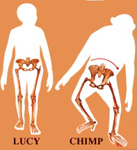We can observe the modification of the pelvis and hip joint necessary for bipedalism in the image on the right, which contrasts "Lucy," the 3.5 million year old Australopithecus afarensis, with a chimp. Lucy was fully bipedal and had an erect, human-like posture.
It is interesting to note in this regard that the complex changes associated with bipedalism appear to be present in earlier hominid species ranging in age to six million and perhaps even 7 million years. Bipedalism and erect posture are thus characteristics of all hominids, not of humans alone. On the basis of present evidence, then, erect posture and bipedalism preceded the emergence of human species, and therefore human behavior and culture, by several million years. Though it arose in populations that lived in woodland environments, the evolution of this mode of walking enabled the descendents of these early hominids to survive and flourish in the drier climate which prevailed after 3 million years in bush or open grasslands.

The young Homo ergaster boy to the right, a member of an early human species nearly 2 million years old, is gracefully and athletically bipedal, suggesting a complete adaptation of early human anatomy to its challenging African habitat. By this point in the fossil record, the freeing of the hands for other tasks, which is a by-product of bipedal anatomy, was beginning to have consequences in the emergence of a distinctly human way of life: tool making according to prescribed patterns or concepts and control of fire were being practiced and passed down from generation to generation.


